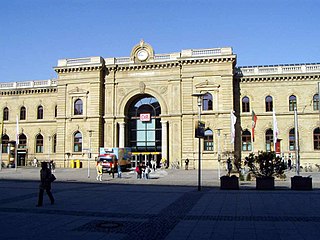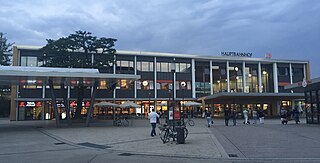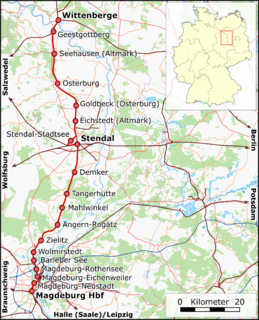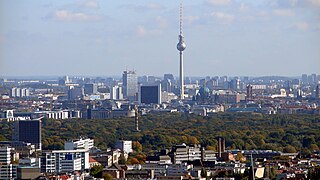
The Hanover–Berlin high-speed railway is a 258 kilometre railway line linking the German cities of Hanover and Berlin

The Duchy of Brunswick State Railway was the first state railway in Germany. The first section of its Brunswick–Bad Harzburg railway line between Brunswick and Wolfenbüttel opened on 1 December 1838.

The Berlin-Anhalt Railway Company was a railway company in Prussia. The railway connection between Berlin and Köthen, built by the BAE, was one of the first long-distance railways in Germany.
The Bremen State Railway was a railway line built by the Free Hanseatic City of Bremen on Prussian state territory. In spite of its name and although owned by the state it was operated under Prussian law as a private railway. Constructionally it formed the 97 km long Uelzen–Langwedel railway, the western section of the America Line.

The Magdeburg–Leipzig railway is a double-track, electrified railway in the German states of Saxony-Anhalt and Saxony, connecting Magdeburg via Köthen, Halle and Unna to Leipzig.

The Brunswick–Magdeburg railway is an 83-kilometre-long (52 mi) German main line railway. It is with the Berlin–Lehrte railway and the Hanover–Berlin high-speed line one of the most important east-west lines between Hanover and Berlin. Important intermediate stations are Königslutter, Helmstedt and Eilsleben.

The Hanover–Brunswick Railway is a German main line railway in Lower Saxony and is one of the oldest lines in Germany, opened in 1843 and 1844. It was the first railway line linking to the city of Hanover and the first operating line of the Royal Hanoverian State Railways. It is now one of the main routes for east-west traffic. The main intermediate station is Peine.

Hildesheim Hauptbahnhof is the main railway station for the city of Hildesheim in Lower Saxony, Germany. The station opened in 1961 and is located on the Lehrte–Nordstemmen, Hildesheim–Brunswick and Hildesheim–Goslar railway. The train services are operated by Deutsche Bahn, Erixx, Metronom and NordWestBahn.

The Berlin–Wrocław railway was a German private railway that connected Berlin and Wrocław. It is one of the oldest lines in Germany, opened between 1842 and 1847 and acquired by the Prussian government in 1852. In 1920, it became part of the German national railways along with the rest of the Prussian state railways.

Lehrte is a railway station located in Lehrte, Germany. The station opened on 15 August 1843 and is located on the Berlin-Lehrte Railway and Hanover–Brunswick railway. The train services are operated by Deutsche Bahn, WestfalenBahn and Metronom.

Stendal is a railway station in the town of Stendal, Saxony-Anhalt, Germany. The station lies on the Berlin-Lehrte railway, Hanover–Berlin high-speed railway, Magdeburg-Wittenberge railway, Stendal–Uelzen railway, Stendal-Tangermünde railway and Stendal–Niedergörne railway. It is an important railway hub for regional trains and is also used by Intercity and Intercity-Express (ICE) trains regularly. Until the winter 2012 timetable Stendal station was only by Deutsche Bahn trains. Since December 2012, the station has also been served by some services operated by Ostdeutsche Eisenbahn. It is classified by Deutsche Bahn as a category 3 station.
The Dessau–Köthen railway connects the cities of Dessau-Roßlau and Köthen in the German state of Saxony-Anhalt. It is one of the oldest lines in Germany and forms the western end of the main line of the Berlin-Anhalt Railway Company. The only passenger services to use the line are regional services.
The Köthen–Aschersleben railway is one of the oldest railway lines in Germany, with its eastern half opened in 1846. It forms an east-west link in the state of Saxony-Anhalt and connects several major towns.

The Magdeburg-Wittenberge railway is a two-track, electrified main line in the east of the German state of Saxony-Anhalt. It is one of the oldest lines in Germany, opened in 1849 by the Magdeburg-Wittenberge Railway Company, which operated it until 1863, when it was taken over by the Magdeburg-Halberstadt Railway Company. It was nationalised in 1879.
The Halle–Vienenburg railway is a 123 kilometre long non-electrified main line north of the Harz Mountains in central Germany. It is an important connection between the metropolitan area of Halle (Saale) and the northern Harz mountains. It was opened in several sections between 1862 and 1872 by the Magdeburg–Halberstadt Railway Company and is now maintained by DB Netz except for the disused section between Heudeber-Danstedt and Vienenburg. Since 1996, traffic between Heudeber-Danstedt and Vienenburg has used the railway via Wernigerode running further to the south.
The Hanover-Altenbeken Railway Company was among the companies of the German "railway king" Bethel Henry Strousberg. Its route network at the end of the first phase consisted of two lines, Hanover–Altenbeken and Weetzen–Haste. In addition, a branch line was opened from Linden-Küchengarten to Linden-Fischerhof for freight transport. The Löhne–Hamelin–Hildesheim–Vienenburg line was built in a second phase up to 1875. The section to Hildesheim is now known as the Weser railway, further east it is operated as the Hildesheim–Goslar line. This extended the network from the Weser Uplands to the Harz.
The Hildesheim–Goslar railway is a 53 kilometre long, double-track and non-electrified main line in the northern Harz foothills in the German state of Lower Saxony. It serves mainly to connect with the tourist region in the northern Harz with Hildesheim and Hanover. It is served by the HarzExpress, running between Halle, Halberstadt, Goslar and Hannover Hauptbahnhof. The most important station and junction of the line is Salzgitter-Ringelheim station.
The Vienenburg–Langelsheim railway was a nearly 18-kilometer-long railway along the northern edge of the Harz in the German state of Lower Saxony. It was mainly used for freight traffic. It was opened in 1875, but it lost its importance with the closure of a line connecting to the east as a result of the division of Germany after the Second World War and it is now closed and dismantled.




















